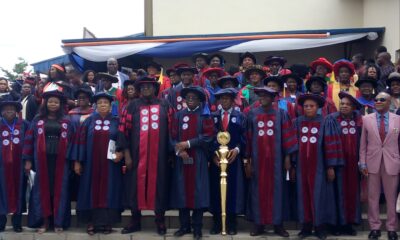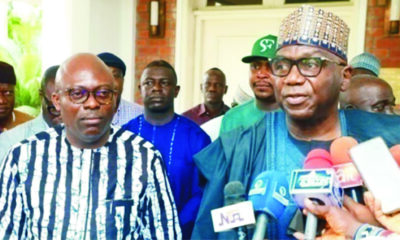Oil & Energy
SPDC, Journalists Partner On Pipelines’ Protection
Crude oil theft and
pipeline vandalism have remained two notorious factors militating against the desire for high productivity and target actualization in the Nigerian Oil and gas sector; with both accounting for billions of dollars loss to the Federal Government and the International Oil Companies (IOCs), annually.
However, last Tuesday one of the oil multinationals, Shell Petroleum Development Company of Nigeria (SPDC) drew the attention of media men to massive encroachment on its pipeline right of way at Oyigbo Local Government Area of Rivers State.
Infact, SPDC manager in charge of pipeline operations, Wenike Princewill lamented that over one hundred such structures were recorded in Oyigbo alone.
The Shell Manager emphasized that about 40 million barrels per day were lost when the company had to shut down operation of its Gas plant in the Oyigbo area due to the enchroachment.
He expressed worry that people live in the houses within the dangerous zone to the pipeline not knowing they were sitting on time bomb. “The pipe contains hydrocharbon which is inflammable as it could result in an explosion and fire”, he said.
A retired primary school teacher, Mrs Chidinma Nkwocha who lives in Oyigbo said some 15 years ago, land in the area was very cheap and people were rushing from different parts of the state and beyond to acquire and develop.
“The pillars were there quite well but they did not care because of the low rate of parcel of land there”, Nkwocha stated disclosing that some of her friends fell prey to dubious elements who were busing selling land they don’t know.
Oyigbo is a sub-urban city close to Port Harcourt, observers said high cost of land in Port Harcourt might have made people to be attracted to Oyigbo due to the closeness especially as land was very scarce in Port Harcourt City.
However, the hard reality owners of the structures would have to face is to loose such property since owning them is illegal.
Or would they choose to remain there and get consumed with their property and family members when devil’s appointed time comes?
One worrisome revelation is that some of the property were also owned by influential persons in the government who should have desuaded others. Presumably, their presence could have encouraged the ordinary members of the society to acquire such illegal spaces.
The Ministry of Ubrban Development and relevant agencies, definitely do not have to wait anymore but to commence steps that could correct the anomalies. The so much delay in taking action or rather, in action contributed to the compounded situation.
Such inactions by the appropriate government agencies have largely encouraged enchrochment in diverse ways. Take for instance, the public roads, it took courage in the part of the present government to demolish houses built in total disregard to law guiding right of way.
The various Committees in the National Assembly, also have responsibility and should be part of the campaign.
SPDC Manager, Government and Community Relations said the company remain committed to addressing social and developmental challenges affecting the communities in which they operate and solicited for the collaboration of the media in the campaign against encroachment into the company’s facilities.
It was resolved that authorities of the company should increase their sensitization programme on the issue and also localise it so that the ordinary people in the remote areas particularly the company’s host communities could get the awareness.
Regular gingles in the mass media on the campaign message would also help in educating the people on the danger of encroaching on such dangerous zone as pipeline.
Those who sold the land that does not belong to them may as well be called to question at least to defend their actions, they may as well face prosecution.
The impact of oil theft, vandalism of pipelines and the new challenge of encroachment of pipeline right of ways are scaring enough.
Though the company denied that its divestment onshore in preference to more investment offshore may obviously be linked to the increasing challenges be develling its operations in the country.
SPDC Manager, Government and Community Relations, Fufeyin Funkakpo reiterated the commitment of the company to issues of community development stressing that loss incurred by the company in shutting down its facilities due to sabotage invariably affects the economy of the action and its capacity to increase it commitment to community development.
The Chairman of Nigeria Union of Journalists (NUJ) in Rivers State, Mr. Opaka Dokubo commended SPDC for the senminar noting that it has increased their knowledge of the operations.
Dokubo who was represented by the Vice Chairman of the State NUJ, Mr. Omoni Ayo-Tamuno, particularly commended SPDC for the medical test, treatment and health lecture saying it would benefit the journalists greatly.
Chris Oluoh
Oil & Energy
FG Explains Sulphur Content Review In Diesel Production
The Federal Government has offered explanation with regard to recent changes to fuel sulphur content standards for diesel.
The Government said the change was part of a regional harmonisation effort, not a relaxation of regulations for local refineries.
The Chief Executive, Nigerian Midstream and Downstream Petroleum Regulatory Authority (NMDPRA), Farouk Ahmed, told newsmen that the move was only adhering to a 2020 decision by the Economic Community of West African States (ECOWAS) which mandated a gradual shift to cleaner fuels across the region.
Ahmed said the new limits comply with the decision by ECOWAS that mandated stricter fuel specifications, with enforcement starting in January 2021 for non-ECOWAS imports and January 2025 for ECOWAS refineries.
“We are merely implementing the ECOWAS decision adopted in 2020. So, a local refinery with a 650 ppm sulphur in its product is permissible and safe under the ECOWAS rule until January next year where a uniform standard would apply to both the locally refined and imported products outside West Africa”, Ahmed said.
He said importers were notified of the progressive reduction in allowable sulphur content, reaching 200 ppm this month from 300 ppm in February, well before the giant Dangote refinery began supplying diesel.
Recall that an S&P Global report, last week, noted a significant shift in the West African fuel market after Nigeria altered its maximum diesel sulphur content from 200 parts per million (ppm) to around 650 ppm, sparking concerns it might be lowering its standards to accommodate domestically produced diesel which exceeds the 200 ppm cap.
High sulphur content in fuels can damage engines and contribute to air pollution. Nevertheless, the ECOWAS rule currently allows locally produced fuel to have a higher sulphur content until January 2025.
At that point, a uniform standard of below 5 ppm will apply to both domestic refining and imports from outside West Africa.
Importers were previously permitted to bring in diesel with a sulphur content between 1,500 ppm and 3,000 ppm.
It would be noted that the shift to cleaner fuels aligns with global environmental efforts and ensures a level playing field for regional refiners.
Oil & Energy
PHED Implements April 2024 Supplementary Order To MYTO
The Port Harcourt Electricity Distribution (PHED) plc says it has commenced implementation of the April 2024 Supplementary Order to the MYTO in its franchise area while assuring customers of improved service delivery.
The Supplementary order, which took effect on April 3, 2024, emphasizes provisions of the MYTO applicable to customers on the Band A segment taking into consideration other favorable obligations by the service provider to Band A customers.
The Head, Corporate Communications of the company, Olubukola Ilvebare, revealed that under the new tariff regime, customers on Band A Feeders who typically receive a minimum supply of power for 20hours per day, would now be obliged to pay N225/kwh.
“According to the Order, this new tariff is modeled to cushion the effects of recent shifts in key economic indices such as inflation rates, foreign exchange rates, gas prices, as well as enable improved delivery of other responsibilities across the value chain which impact operational efficiencies and ability to reliably supply power to esteemed customers.
“PHED assures Band A customers of full compliance with the objectives of the new tariff order”, he stated.
Ilvebare also said the management team was committed to delivering of optimal and quality services in this cost reflective dispensation.
The PHED further informed its esteemed customers on the other service Bands of B, C D & E, that their tariff remains unchanged, adding that the recently implemented supplementary order was only APPLICABLE to customers on Band A Feeders.
Oil & Energy
Renewable Energy Boom With Waste Problem

As the global renewable energy capacity increases, so does the amount of waste from end-of-life equipment from solar, wind and other renewable energy activities. If we don’t address this problem soon, it could become a whole new threat to the environment and human health.
While a transition away from fossil fuels to alternative green energy sources is helping the world to reduce its greenhouse gas emissions and combat climate change, it is important to consider the implications that new energy activities may have on the environment.
Solar panels and wind turbines have a limited lifespan and need to be disposed of appropriately once they reach this point. While some components can be recycled and reused, much of the old equipment ends up in landfills due to the lack of infrastructure in place to manage the materials suitably.
Renewable energy equipment, such as solar panels, contains components that can be harmful to humans, such as lead and cadmium, as well as other materials, like glass, aluminum, and silicon, which can be harmful to the environment if disposed of improperly.
One way that out-of-use equipment can be managed is through the creation of standards, such as the Waste Electrical and Electronic Equipment (WEEE) directive from the European Union, which provides guidelines for the gathering, handling, recycling, and recovery of solar panels.
The U.S. Resource Conservation and Recovery Act (RCRA) also addresses the correct disposal of solar panels.
However, many countries have yet to introduce clear standards for renewable energy equipment disposal, which has led to dangerous methods of disposal.
Several countries around the globe are rapidly increasing their solar and wind energy capacity, which relies on the production and installation of millions of solar panels and turbines. Tens of millions of solar panels are being installed each year in the U.S. alone, and globally the figure is over a hundred million.
Despite the accelerated pace of the rollout, there are few recycling facilities prepared to manage old equipment.
Some countries are managing equipment disposal better than others. For example, France claims that 90 percent recycling efficiency is achieved in some of its flagship disposal facilities.
However, others do not have mechanisms in place to even consider recycling old equipment. While it is important to put proper waste disposal mechanisms in place for the safety of people and the environment, it can also be a lucrative business.
According to a study by the International Renewable Energy Agency (IRENA) and the U.S. Department of Energy’s National Renewable Energy Laboratory (NREL), the cumulative value of materials that can be recycled from solar photovoltaic (PV) waste is estimated at $4 billion by 2040 and $8.8. billion by 2050.
Supplies of many of the materials used to produce green energy equipment are finite, meaning it is important to recycle materials to reproduce equipment to continue to produce renewable energy. Jinlei Feng, a programme officer at IRENA, explained, “By 2050, there will be more than 210 million tonnes of cumulative solar PV waste globally and more than three-quarters of that waste will be generated after 2040 and 40% in the last five years between 2045-2050”.
Feng added, “Annual solar PV waste generation will touch 10 million tonnes by 2040 and increase to 20 million tonnes by 2050”.
India is currently trying to navigate solar waste problem. Pavagada in the south of India is home to the world’s third-largest solar power plant, which holds 25 million panels across a 50 km2 park, with a capacity of 2,050MW. There are 11 other giant solar parks across the country, with plans to develop a further 39 across 12 states by 2026.
However, with great solar ambitions comes significant waste. India is aiming for a solar output capacity of 280GW by 2030, of which 70.1GW is already installed.
One study predicts that this will produce an accumulation of over 600,000 tonnes of solar waste by the end of the decade, which could increase 32-fold to over 19 million tonnes by 2050.
Although there are protocols in place to manage the disposal of old equipment, which state that solar waste from the plants must be transferred to e-waste contractors, authorized by the Central Pollution Control Board (CPCB), within a specified timeframe – typically 90 or 180 days – few abide by these rules.
Most solar farms are in remote areas and must pay to transport old equipment to authorised contractors. Solar glass has no real value, meaning there is little incentive for waste contractors to collect and manage the equipment.
This has led to the development of a network of informal operators – who dismantle, aggregate, transport and recycle panels.
Instead of ensuring proper disposal methods are followed, many operators sell their waste equipment to informal buyers, meaning the materials cannot be recycled and repurposed, and many of the materials end up harming both people and the environment.
To ensure that renewable energy equipment is disposed of appropriately, and recycled where possible, governments must establish clear standards and regulations for energy waste disposal.
Further, they must ensure the mechanisms are in place and funding is available to guarantee proper disposal takes place. Without the necessary standards, green energy equipment could contribute to environmental and health problems in the coming decades.
Bradstock writes for Oilprice.com.
By: Felicity Bradstock
-

 Rivers3 days ago
Rivers3 days agoPolice Arrest Vigilante Commander, Others Over Robbery In Rivers
-

 Education3 days ago
Education3 days agoFormer VC Advocates Drug Test For University Lecturers
-

 News3 days ago
News3 days agoSpeak Truth To Power, Prof Omotola Tells Journalists
-

 Politics3 days ago
Politics3 days agoBayelsa Repositioning Local Councils For Service Delivery – D’Gov
-

 Nation3 days ago
Nation3 days agoWIW: Banigo Advocates Legislative Impetus
-

 News3 days ago
News3 days agoLet’s Fight To Save Rivers’ Soul Together
-

 Politics3 days ago
Politics3 days agoMakinde Hails Electorate, OYSIEC Over LG Poll Conduct
-

 Rivers3 days ago
Rivers3 days agoCleric Attributes Nigeria’s Unity To God’s Grace

